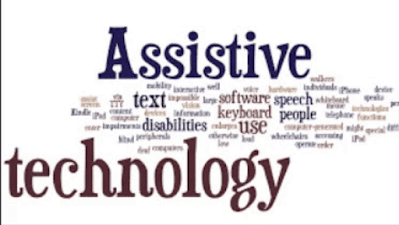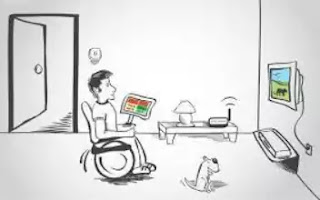What Is Assistive Technology
Assistive technology alludes to equipment and programming intended to help individuals with incapacities. A few kinds of assistive technology give physical help, while others give accommodating guides to people with learning incapacities. It is assistive, versatile, and rehabilitative gadgets for individuals with handicaps or the old populace. Individuals who have inabilities frequently experience issues performing exercises of everyday living (ADLs) freely, or even with help. ADLs are self-care exercises that incorporate toileting, portability (ambulation), eating, washing, dressing, prepping, and individual gadget care. Assistive technology can improve the impacts of inabilities that limit the capacity to perform ADLs. Assistive technology advances more prominent freedom by empowering individuals to perform assignments they were once in the past incapable to achieve or had extraordinary trouble achieving, by giving improvements to, or changing strategies for interfacing with, the technology expected to achieve such undertakings. For instance, wheelchairs give free portability to the individuals who can't walk, while assistive eating gadgets can empower individuals who can't take care of themselves to do as such. Because of assistive technology, individuals with inabilities have a chance of a more sure and accommodating way of life, with an expansion in "social interest," "security and control," and a more prominent opportunity to "decrease institutional expenses without altogether expanding family unit costs.
What is Assistive Technology Evaluation
In this highly technological world, few of us perform our functions without dependence on technology. You cannot submit your question and receive answers from any place in the world without access to technology; farmers use drip irrigation controlled by technology; health care is now administered through smartphones and online education is filling in the gaps while schools are closed due to the coronavirus. The trend is that in ten or so years, about 50% of present job descriptions will be obsolete due to digital displacement. We have smart cities, smart buildings, smartphones, smart warehouses, and the list is infinite.
My point is that each of us is digitally or technologically dependent and we need to do our self-analysis (or if a business to have a professional evaluation made) to determine what knowledge and devices we need to stay current.
Services of Assistive Technology
➟ 2Demonstration:- Many assistive gadgets from an assortment of sellers are accessible on location. People may come in and evaluate a particular bit of hardware hands-on to ensure it will work for them before buying.
➟ Evaluation and Consultation:- Formal appraisals of need and suggestion concerning assistive innovation is accessible for people all things considered and all inabilities.
➟ Training:- Experts give preparing on all zones of assistive innovation. Preparing is accessible to people and gatherings, clients, guardians, and experts on the most proficient method to appropriately utilize assistive gadgets and programming programs.
➟ Low-Vision Services:- Experts can exhibit better approaches to utilize amplification and talking innovation to improve each day's life for individuals with vision misfortune. Classes are continuous in direction/versatility, fundamental abilities, (for example, cooking), non-visual PC use, change under visual deficiency, workmanship, and so on.
➟ Custom Design:- Not all needs are met by accessible hardware. Signal Centers' Design Specialist can adjust existing items or plan and manufacture new answers to address the customer's issues.
➟ Loan and Reuse:- Numerous gadgets are accessible for either present moment (for example for preparing, to test, while fixes are made, and so forth.) or perpetual position. This program permits utilitarian hardware under the control of the individuals who need it yet couldn't in any case manage the cost of it.
➟ Employment Services:- Advancing positive results for individuals with incapacities by helping with getting ready for, acquiring, and looking after work. Administrations incorporate employment status, a quest for new employment, work situation, work maintenance, and pre-employment change. This program works in an organization with the State of Tennessee's Vocational Rehabilitation and the Georgia Vocational Rehabilitation Agency.
➟ Workplace & Accommodations:- Getting to a worksite and dissecting undertakings to perceive what modifications should be made for a person's capacities. This can empower an organization to make fresh recruits or hold workers who have gotten crippled.
The presentation of assistive innovation into the life of an individual with a handicap requires an investigation of the current limits of the individual, the settings where the innovation will be utilized, the highlights remembered for the gadget, and the objectives of the customer and their family, boss, and teacher. Medical coverage may likewise affect which gadgets patients may buy at diminished or no expense. Much of the time, all together for assistive innovation to be considered restoratively essential, a doctor must sign and send to the element that will pay for the gadget a letter that depicts the person's conclusion and anticipation and the capacities that will be improved or kept up by the mentioned gadget.
When a gadget is procured, administrations might be expected to fit, modify, keep up, or fix it. These administrations are given by clinical hardware organizations, recovery offices, or volunteer associations. An extra significant however frequently ignored help is the preparation or specialized help given to the buyer and their family in the utilization of assistive innovation. For instance, people must figure out how to utilize correspondence sheets that permit people with no or inadequately comprehended discourse to make their necessities and perspectives known.
Also, Check Out - Augmented Analytics - All Information You Should Know
Advancement of Assistive Technology
Progressions in assistive-innovation gadgets have come generally because of advances in innovation largely. In any case, upgrades in the administrations related to assistive innovation and in government approaches, and projects applicable to assistive innovation have additionally powered advancement in the plan and utilization of gadgets. The Internet turned out to be progressively significant for debilitated people as a spot where they could buy gadgets that were generally hard to track down. Nonetheless, the Internet when all is said in done has gotten progressively subject to interactive media including complex illustrations, liveliness, and discernible wellsprings of data, which present a noteworthy test in the recovery of data for the debilitated. This is the case particularly for individuals who are visually impaired or hard of hearing. To beat these issues, strategy creators, purchaser backers, and others have been attempting to create monetary assets for impeded people to buy PCs and access the Internet and to urge Web webpage engineers to work in openness highlights in their standard gadgets.
Different advances in assistive innovation are in progress for handheld, compact, and satellite-based correspondence. Control interfaces that straightforwardly sense signals from the cerebrum or nerves are by and large additionally created to permit more noteworthy control of gadgets by individuals with serious physical handicaps. Insightful interfaces are needed to adjust to the necessities of people with incapacities to permit more noteworthy support in work, entertainment, and self-care. Gadgets that can communicate messages from the mind to enact target muscles (e.g., fingers, arms, feet, legs) without going through the spinal string are moving from essential examination labs to clinical preliminaries. Comparable advancement has been made for gadgets dependent on direct incitement of the cerebrum for those with visual and hearing misfortune. Likewise, as materials themselves, advance, wheelchairs and other assistive-innovation gadgets are required to get lighter, more grounded, and more strong than existing items.
Different advances in assistive innovation are in progress for handheld, convenient, and satellite-based correspondence. Control interfaces that straightforwardly sense signals from the cerebrum or nerves are in effect additionally created to permit more prominent control of gadgets by individuals with extreme physical inabilities. Clever interfaces are needed to adjust to the necessities of people with inabilities to permit more noteworthy cooperation in work, amusement, and self-care. Gadgets that can communicate messages from the mind to initiate target muscles (e.g., fingers, arms, feet, legs) without going through the spinal rope are moving from essential exploration research centers to clinical preliminaries. Comparable advancement has been made for gadgets dependent on direct incitement of the cerebrum for those with visual and hearing misfortune. What's more, as materials themselves advance, wheelchairs and other assistive-innovation gadgets are relied upon to get lighter, more grounded, and tougher than existing items.
How Does Assistive Technology Help People with Disabilities
➟ Mobility aids, such as wheelchairs, scooters, walkers, canes, crutches1, prosthetic devices, and orthotic devices.➟ Hearing aids to help people hear or hear more clearly.
➟ Cognitive aids, including computer or electrical assistive devices, to help people with memory, attention, or other challenges in their thinking skills.
➟ Computer software and hardware, such as voice recognition programs, screen readers, and screen enlargement applications, to help people with mobility and sensory impairments use computers and mobile devices.
➟ Tools such as automatic page-turners, book holders and adapted pencil grips to help learners with disabilities participate in educational activities.
➟ Closed captioning to allow people with hearing problems to watch movies, television programs, and other digital media.
➟ Physical modifications in the built environment, including ramps, grab bars, and wider doorways to enable access to buildings, businesses, and workplaces.
➟ Lightweight, high-performance mobile devices that enable persons with disabilities to play sports and be physically active.
➟ Adaptive switches and utensils to allow those with limited motor skills to eat, play games, and accomplish other activities.
➟ Devices and features of devices to help perform tasks such as cooking, dressing, and grooming; specialized handles and grips, devices that extend reach, and lights on telephones and doorbells are a few examples.
Advantages of Assistive technology
➟ Assistive technology can screen the wellbeing of a weak individual in their own home 24 hours every day, 7 days per week – giving significant serenity to both themselves and their family. This can be especially valuable while having proficient vocations available day and night isn't attractive or reasonable.
➟ It very well may be an acceptable approach to enhance other considerations and backing plans.
➟ The technology is progressively accessible to get yourself, and there are additional alternatives that might be offered by your nearby gathering.
➟ It can permit relatives or companions to play a positive part in a friend or family member's home consideration, regardless of whether they don't live close by. For instance, you can perceive how your relative is adapting through observing technology and your PC, permitting you to telephone them at the perfect time.
➟ Individual cautions and telecare can assist with guaranteeing a snappier reaction if there is a major issue. For occurrences, for example, a fall or a health-related crisis like a stroke, a snappier reaction can assist with diminishing the drawn-out antagonistic impacts of the episode.
➟ Some assistive technology can be joined into ordinary gadgets to help autonomous living – for instance, available cell phones, extraordinarily adjusted controllers, or voice-enacted shrewd home centers.
➟ Sometimes, technology can be a more savvy alternative than paying for normal consideration. Peruse our tips on picking and purchasing assistive technology.
With the presentation of assistive technology, a few people with incapacities found that they had the option to perform exercises without the assistance of relatives or paid partners. For instance, some handicapped people had the option to take an interest in child-rearing, improve work efficiency, and participate in dynamic recreational exercises. Others had the option to abstain from being organized. In any case, albeit numerous individuals with inabilities report that the utilization of assistive technology has enormously improved their satisfaction, estimation of progress in their fulfillment, confidence, versatility, wellbeing, and capability has been minimally examined. This has incited the improvement of a few methods for dispassionately assessing the advantages of assistive technology.
The Quebec User Evaluation of Satisfaction with Assistive Technology (QUEST) gathers data about the advantages of assistive technology and endeavors to quantify people's satisfaction with their gadgets. A journey utilizes various kinds of factors to quantify user satisfaction, including those that consider nature, relevant highlights of the individual's mentalities, desires, and discernments, just as the qualities of the assistive technology itself. A journey permits the user to decide the overall significance of the satisfaction variable. The Psychosocial Impact of Assistive Devices Scale (PIADS) is a poll that gives a proportion of user discernment and other mental components related to assistive-technology gadgets. Three segments of PIADS are versatility, ability, and confidence. PIADS has been applied to the estimation of results with an assortment of assistive-technology gadgets, from eyeglasses and contacts focal points to ADLs. PIADS and QUEST give dependable proportions of the customer viewpoint and often are considered related to evaluations of useful status.
Disadvantages of Assistive technology
➟ The technology can appear to be excessively intricate to certain individuals, and this may debilitate them from utilizing it.
➟ The technology can appear to be excessively mind-boggling to certain individuals, and this may debilitate them from utilizing it.
➟ This sort of technology additionally brings up issues of protection, particularly if somebody has not been allowed a chance to agree to its utilization, or if they're not able to do as such because of an absence of intellectual ability
➟ Depending on technology to monitor a more seasoned individual could prompt them to get more separated if it is utilized as a swap for individual visits.
➟ It might influence your necessities appraisal if you supplant existing help with a technology arrangement.
Issues of the plan, purchaser inclination, cost, and strategy can impact the utilization, neglect, or surrender of assistive technology. Different elements are identified with the deserting of assistive-technology gadgets, including disappointment by suppliers to consider customer conclusions, absence of simple gadget acquirement, helpless gadget execution, and changes in buyer needs or needs. A basic segment of the assistive-gadget conveyance framework is a viable cycle that guarantees that the necessities and objectives of the individual are precisely distinguished. Simple gadget acquisition alludes to the circumstance where a buyer acquires a gadget from a provider without an evaluation by a professional supplier. This frequently happens with basic gadgets, for example, props, sticks, or specialist. Helpless gadget execution might be the consequence of mistaken or unseemly desires concerning the user, a crisscross between buyer abilities and gadget qualities, or genuine gadget disappointment.






0 Comments
Don't Spam
Don't Use Harmful or Abusive Word